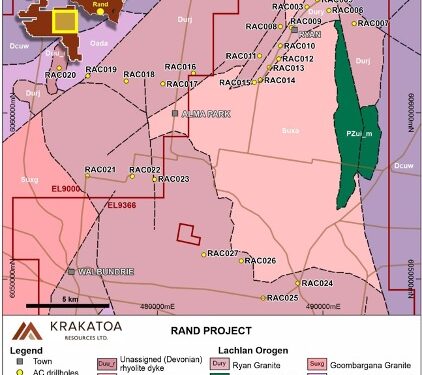Krakatoa Resources Limited (ASX: KTA) has discovered a new clay hosted REE province at the Rand Project in NSW, Australia.
First-pass air-core (AC) drilling on new, high- priority REE targets at the Rand Project in the Riverina region has defined anomalous REEs hosted in clay-weathered granites at shallow depths.
Final assays have been received for the roadside easement AC drilling completed in the March 2023 quarter. Drilling has led to the company making the clay-hosted REE discovery at Rand, supported by numerous significant intersections from clay-weathered saprolites developed on the Ryan and Jindera Granites.
“Our Rand project continues to deliver significant outcomes for the company and these assay results from first pass, wide-spaced AC drilling are highly encouraging and proved that these selective Granite types have the potential to host shallow clay REE deposits,” CEO, Mark Major, said.
“In addition to these encouraging results, the Ryan and Jindera Granites have sizeable footprints that we look forward to investigating further. Although our focus remains on our Mt Clere project in Western Australia, our NSW portfolio continues to demonstrate excellent potential for major discoveries.”
Twenty-seven vertical AC holes RAC001 to 027 inclusive for 1318.7m were drilled. Twelve holes tested the Ryan Granite at ~ 1km centres along 7.5km of (NE-SW) strike, another 12 holes tested the northern Jindera Granite as wide-spaced fences with 1.5km to 2.5km spacings and RAC020 tested an unassigned Devonian rhyolite dyke.
The final two holes (RAC007 and 011) that targeted Durj intersected Abercrombie Fm. Hole depths ranged from 3.0m to 72m, with a median depth of 54m. Most holes were terminated at the top of saprock, unless terminated sooner due to difficult drilling conditions.
A total of 396 samples (including 21 QA-QC samples) were analysed by ALS Global for REEs and critical metals by method ME-MS81.
The company will now send certain AC samples to an accredited laboratory to undertake simple leach test work to determine the viability for extraction of the key REE such as neodymium, praseodymium, dysprosium and Terbium. Further interpretive work will be completed on the AC drilling programme results before the planning of further shallow drilling.
For further information please visit: https://www.ktaresources.com/












